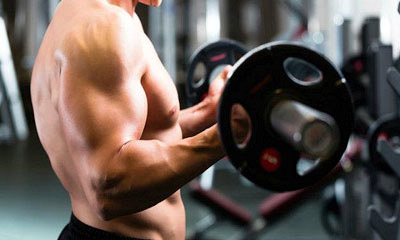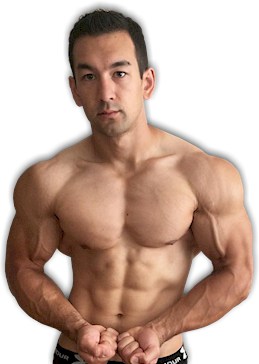HOW TO DO BICEP CURLS: 5 TIPS FOR PERFECT BICEP CURL FORM

Although bicep curls are a very simple exercise to perform on the surface, there are actually many small tweaks you can make to your lifting form to enhance their overall effectiveness and gain bicep size at a faster rate.
Here are 5 simple but highly effective tips you can employ on all of your curling movements – whether it be a standard barbell curl, cable curl or dumbbell curl – to maximize the tension on your biceps and build your upper arms more efficiently…
(You can view a live demonstration of these tips by watching the video below, or you can scroll down further to read the text version instead)
5 Tips For Perfect Bicep Curl Form
Tip #1 – Don’t Allow Your Shoulders And Elbows To Drift Forward
One of the biggest mistakes almost all trainees make when performing bicep curls of any kind is in allowing their shoulders and elbows to drift forward as they curl the weight up.
When the shoulder and elbow drift forward, the stress is taken off of the biceps and is shifted onto the front delts instead.
In order to keep the tension on your biceps at all times throughout your curling exercises, focus on keeping your shoulders and elbows stationary at all times, and moving the weights up using pure force from your biceps only.
If you do this properly you may need to slightly reduce the total amount of weight you’re using, but this should never be a cause for concern in any weight training plan designed for maximum muscle stimulation.
Remember, your muscles have no idea how much weight you’re objectively lifting; they only respond to the direct amount of tension they are placed under.
This technique maximizes the tension on the biceps and thus produces superior results even if it requires you to curl less total resistance.
Tip #2 – Keep Your Elbows Pinned At Your Sides
If you want to get the very best bicep building results from your curling movements, stop making the mistake of flaring your elbows out as you lift the weights up.
Most lifters simply go too heavy on their curls and end up bringing surrounding muscles and joint movements into the equation to power up the weight.
This may allow you to lift heavier loads, but it does nothing when it comes to maximizing the stimulation and development of your biceps.
For every curling movement that you perform, always make sure that your elbows are pinned to your sides at all times and that they remain stationary throughout the entire exercise.
If you allow your elbows to drift out to the sides, all you’re really doing is taking stress off of your biceps and shifting it onto your shoulders and wrists.
Tip #3 – Contract Your Triceps At The Bottom Of Each Rep
At the very bottom of every rep before you curl the weights back up, flex your triceps.
This ensures that your biceps are being fully lengthened on every rep and that they’re being trained through the largest range of motion possible.
This method also helps to eliminate momentum by ensuring that your biceps come to a dead stop before the weights are curled back up.
Tip #4 – Keep Your Wrists Aligned In A Neutral Or Slightly Extended Position
There’s two main problems with flexing your wrist and forearm at the same time that you curl the weights up…
First off, it takes tension off of the biceps and places it onto the wrists and forearms instead. This ultimately results in a less effective bicep workout.
Secondly, the wrists are not intended to lift significantly heavy loads in this position, and this additional stress can very easily lead to wrist and forearm pain.
From now on, always make sure that your wrists remain either neutral, or even better, slightly extended whenever you execute your curling movements.
This will keep the majority of the tension on your biceps while taking the stress off of your wrists and forearms at the same time.
Tip #5 – Keep Your Back Straight And Minimize The Use Of Momentum
How many times have you seen a guy at the gym load up way more weight than he can actually handle and proceed to swing the bar up and down while leaning his torso way back in order to get enough momentum to complete the rep?
It’s incredibly common, and it’s definitely something to avoid.
Trust me, nobody cares how much you can curl, and all this does is put your lower back at a greater risk for injury while bringing surrounding muscles into the equation to assist you in lifting up the weights.
Always select an amount of weight you can handle for at least 5 smooth and controlled reps without leaning back excessively and with minimal to no “swing” in your arms while you curl the resistance up.
How To Do Bicep Curls: Quick Recap
So, just to recap these 5 tips that will improve the effectiveness of your curls and help you gain bicep size at a quicker rate…
1) Don’t allow your shoulders and elbows to drift forward as you curl the weight up.
2) Keep your elbows pinned at your sides at all times.
3) Contract your triceps at the bottom of each rep.
4) Keep your wrists aligned in a neutral or slightly extended position.
5) Keep your back straight and minimize the use of the momentum.
Employ these 5 strategies and I guarantee you’ll notice a big difference in your ability to place maximum tension your biceps while reducing stress on the surrounding muscles and joints.
Also make sure to check out my previous post about structuring an effective step-by-step bicep workout, as this will teach you what you need to know when it comes to proper exercise selection, sets, reps and more.
If you found this article helpful, make sure to sign up for your FREE custom fitness plan below...




